#Industrial Engineering and Operations Research
Explore tagged Tumblr posts
Text
IIT Bombay Introduces New BTech Program in IEOR.

Mumbai: IIT Bombay has launched a new undergraduate degree in Industrial Engineering and Operations Research (IEOR) for the academic year 2024-25.
ALSO READ MORE- https://apacnewsnetwork.com/2024/07/iit-bombay-introduces-new-btech-program-in-ieor/
#IEOR#IEOR program#IIT Bombay#IIT Bombay Introduces New BTech Program in IEOR#Industrial Engineering and Operations Research#JEE Advanced#JEE Main examinations#New BTech Program in IEOR
0 notes
Text






Stobotnik Deus Ex AU.
DR. IVO ROBOTNIK: CEO of Robotnik Industries, scientist, inventor. Works with both the government and private companies to fund his research in exchange for military augmentations, weapons and battle robots. A genius, but is awfully bad at social interactions. Prefers the company of his drones and his Chief of Security. Partly augmented: has cranium augs (hacking, tech control, infolink+cochlear and subvocal implants), immune to social and hormonal enhancers, but can't use them himself, eyes augmentations (tracking, smart vision+wall-piercing vision, retinal prosthesis, HUD, flash-suppresant, radar, topograph, vision and noise feedback) and augmented his arms up to the elbow. His body requires more neuropozyne to adapt to the augmentations.
[DATA EXPUNGED] STONE: Chief of Security in Robotnik Industries, Ivo's personal assistant and bodyguard. Ex-military, ex-CIA. Had his first name wiped off the official records in exchange for his silence about their operation (the assassination attempt on him failed, so they had no choice). Has several degrees, including a barista certificate, has exceptional training in covert ops, field ops and social engineering. Fully augmented (cranium, eyes, social enhancers, arms, legs, heart, lungs, muscles, spine, built-in weaponry) by Dr. Robotnik himself; all of the augmentations are top of the line and are constantly being upgraded by Dr. Robotnik. Requires significantly less neuropozyne than the average human.
#sonic the hedgehog#sonic movie universe#sonic fanart#dr robotnik#ivo robotnik#agent stone#stobotnik#jimbotnik#stobotnik deus ex au#deus ex
774 notes
·
View notes
Text
Dandelion News - March 8-14
Like these weekly compilations? Tip me at $kaybarr1735 or check out my Dandelion Doodles!
1. Caribbean reef sharks rebound in Belize with shark fishers’ help

“Caribbean reef shark populations have rebounded beyond previous levels, more than tripling at both Turneffe and Lighthouse atolls[…. The recovery] arose from a remarkable synergy among shark fishers, marine scientists and management authorities[….]”
2. Landmark Ruling on Uncontacted Indigenous Peoples’ Rights Strikes at Oil Industry

“[T]he Ecuadorian government [must] ensure any future expansion or renewal of oil operations does not impact Indigenous peoples living in voluntary isolation. [… E]ffective measures must be adopted to prevent serious or irreversible damage, which in this case would be the contact of these isolated populations,” said the opinion[….]”
3. America's clean-energy industry is growing despite Trump's attacks. At least for now

“The buildout of big solar and battery plants is expected to hit an all-time high in 2025, accounting for 81% of new power generation[….] The industry overall has boomed thanks to falling technology costs, federal tax incentives and state renewable-energy mandates.”
4. Study says endangered Asian elephant population in Cambodia is more robust than previously thought

“A genetic study of Asian elephants […] reveals a larger and more robust population than previously thought, raising hopes the endangered species could slowly recover. […] “With sufficient suitable habitat remaining in the region, the population has the potential to grow if properly protected,” the report concludes.”
5. Scientists are engineering a sense of touch for people who are paralyzed

“[Engineers are] testing a system that can restore both movement and sensation in a paralyzed hand. [… A]fter more than a year of therapy and spinal stimulation, [… h]is increased strength and mobility allow him to do things like pet his dog. And when he does, he says, "I can feel a little bit of the fur."“
6. Florida is now a solar superpower. Here’s how it happened.

“In a first, Florida vaulted past California last year in terms of new utility-scale solar capacity plugged into its grid. It built 3 gigawatts of large-scale solar in 2024, making it second only to Texas. And in the residential solar sector, Florida continued its longtime leadership streak.”
7. Rare frog rediscovered after 130 years

“The researchers discovered two populations of the frog[….] "The rediscovery of A. vittatus allowed us to obtain, more than a century after its description, the first biological and ecological data on the species.” [… S]hedding light on where and how they live is the first step in protecting them.”
8. Community composting programs show promise in reducing household food waste

“The program [increased awareness and reduced household waste, and] also addressed common barriers to home composting, including pest concerns and technical challenges that had previously discouraged participants from composting independently.”
9. Pioneering Australian company marks new milestone on “mission” to upcycle end-of-life solar panels
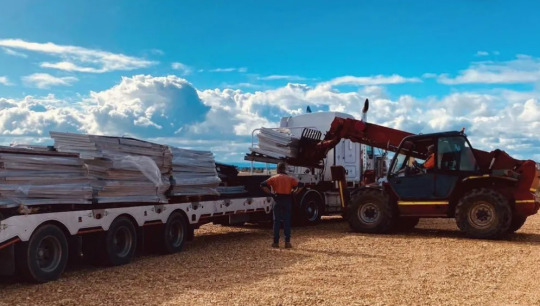
“[…] SolarCrete – a pre-mixed concrete made using glass recovered from used solar panels – will form part of the feasibility study[….] A second stage would then focus on the extraction of high value materials[…] for re-use in PV and battery grade silicon, [… and] electrical appliances[….]”
10. Beavers Just Saved The Czech Government Big Bucks

“The aim was to build a dam to prevent sediment and acidic water from two nearby ponds from spilling over, but the project was delayed for years due to negotiations over land use[….] Not only did the industrious rodents complete the work faster than the humans had intended, they also doubled the size of the wetland area that was initially planned.”
March 1-7 news here | (all credit for images and written material can be found at the source linked; I don’t claim credit for anything but curating.)
#hopepunk#good news#shark#fishing#nature#ecuador#first nations#oil drilling#clean energy#solar energy#solar power#elephants#elephant#conservation#animals#science#medicine#paralyzed#florida#solar panels#frogs#endangered species#endangered#compost#community#australia#recycling#beaver#habitat restoration#beaver dam
146 notes
·
View notes
Text
I’ve been doing some research into WWII for a while now, and considering Tom Riddle grew up during that time I thought I’d detail what his life during the summers was probably like at the orphanage.
(Note that it’s hard to find information, so some of this is more guessing and not fully backed.)
There were two blitzes, the first one being from September 7, 1940 to May 11, 1941 while the baby blitz was from January 21 to May 29 in 1944 (he would be an adult by that summer so I guess it’s not relevant). This means that Tom wasn’t in London during the blitz, but he was there for the aftermath.
This means that when Tom returned from Hogwarts in 1941 it was likely he had to aid in the clearing of rubble. At this time he was fourteen which means that he was most likely working a full time job which wasn’t uncommon at the time for 14-17 y/o’s. This means that Tom either spent most of his summer either clearing rubble or was working in major industries at the time (engineering, aircraft production, shipbuilding, etc…).
I think this is very likely considering he was living in an orphanage and at this time many orphanages in London were operating in over capacity. It is extremely likely the older kids were forced to work to make some income no matter how little and support themselves. The youngest were probably sent to the countryside before the blitz to be kept safe, but I highly doubt the orphanage would have the resources to completely relocate and they were still needed in London.
This means Tom was working full time every summer from the age of 14 to 16/17 (completely dependent on when he left). When he was sixteen Tom could have participated in the Civil Defence and from what I’ve read some form of national service was required at this age. This means Tom could have very well been participating in Civil Defence or something similar.
Nightly during 1941 and 1942 the air raid sirens would go off and people would have to go to the closest tube of air raid shelter so that is likely where most nights were spent. These places were often extremely crowded as well, people basically laying shoulder to shoulder. For someone like Tom I assume this meant getting no sleep whatsoever.
I couldn’t find information on bombs being dropped outside of the blitzes, but I do think it was possible. So, Tom may have lived through a few bombings, but not to the extent of what happened during the blitzes.
Rationing was a large thing at this time and considering Tom was older at this time he would not get as much aid. There is a high probability that he wasn’t eating enough for what he was doing. Including food clothes were rationed significantly and Tom would be at the peak of his growth at this time and considering how tall he is getting fitting clothes would have been extremely difficult. Though minors were given more clothing coupons at this time due to growth.
Rationing also brought the need for people to grow their own food, so Tom and the other children would most likely be responsible for growing and harvesting food.
Now, this goes into theory territory.
I do believe there is a high chance Tom was kicked out of the orphanage for large amounts of time during the summers due to him being old enough to work and little space and resources. This means he was probably homeless a couple times over the summer, and possibly he was for several summers altogether. He also wasn’t liked at Wool’s so this makes it even more likely.
If anyone wants me to go more into detail on any of these points please send me an ask because I would love to.
#tom riddle#tom marvolo riddle#hp#wwii era#1941#1942#muggle london#tom riddle headcanon#kind of#it’s historically based i guess#tom riddle and wwii#hp headcanon#hp thoughts#hp meta#tom riddle theory
43 notes
·
View notes
Text
EXPOSED: The Hidden Network of 10,000 Deep Underground Military Bases (D.U.M.B.s) – A Global Conspiracy Unveiled
Beneath our feet lies a world shrouded in darkness and secrecy—a network of over 10,000 Deep Underground Military Bases (D.U.M.B.s) that stretch across the globe. These aren’t just military bunkers; they’re part of a sinister plan by the global elite to maintain control over humanity, operating far beyond the reach of any government oversight.
The Dark Underworld: 10,000 D.U.M.B.s Across the Planet Imagine a vast labyrinth of underground bases, hidden from the public eye, where the most horrific activities take place. Over 10,000 of these bases exist worldwide, with 1,800 in the United States alone. These facilities aren’t just military outposts; they are massive underground cities connected by high-speed trains, built for purposes that defy the imagination.
Unthinkable Atrocities: Human Captivity and Bio-Experiments Within these bases, unspeakable horrors are said to occur. Reports of human experimentation, especially on children, are whispered among those who dare to investigate. These facilities allegedly host bio-research labs developing weapons designed to target specific DNA, viruses meant to decimate populations, and other forms of biological warfare. These aren’t just theories—they’re terrifying realities hidden from the world.
The Elite's Secret Army: Engineered Super Soldiers One of the most disturbing revelations is the existence of engineered super soldiers, bred and conditioned within these D.U.M.B.s. These soldiers, created through a twisted combination of genetic engineering and cybernetics, are designed to be the ultimate weapons—loyal, fearless, and nearly invincible. Their purpose? To protect the secrets of these underground bases and to enforce the will of the global elite.
The Vatican-Jerusalem Tunnel: A Sinister Connection Adding to this web of deceit is the recent discovery of a 1,500-mile tunnel connecting the Vatican to Jerusalem, reportedly filled with a staggering hoard of gold. This treasure trove, transported by an armada of 650 planes, is rumored to be part of the Vatican’s secret wealth, hidden away for centuries and now uncovered as part of this global conspiracy.
A Global Web of Control: The Super Elites At the heart of this conspiracy are the so-called "Super Elites"—a tiny fraction of the global population who pull the strings from the shadows. These are the same elites who control the military-industrial complex, the media, and even the highest levels of government. Their reach is so vast that over 800 million individuals within the global military and intelligence complex answer to them, ensuring that their grip on power remains unchallenged.
The Puppet Masters: Rothschilds, Rockefellers, and Khazarian Bloodlines Behind the scenes, powerful families like the Rothschilds and Rockefellers, along with ancient Khazarian bloodlines, have been orchestrating this control for centuries. Their influence spans continents, manipulating world events to maintain their dominance. Their goal is not just to amass wealth but to control humanity itself.
The White Hats: A Glimmer of Hope But not all hope is lost. A group of brave individuals within the military, known as the White Hats, are fighting back. These warriors operate in the shadows, working tirelessly to expose the truth and dismantle the structures of oppression. They are the last line of defense against this global conspiracy, dedicated to restoring justice and freedom to humanity.
The Final Hour: A Call to Action We stand on the brink of a new era, where the truth will finally be revealed. The age of ignorance is over. The forces of darkness will be exposed, and the world will see the light of truth. But we must be vigilant and ready to act. The future of humanity depends on our willingness to confront the darkness and reclaim our freedom. The time for revelation is now—will you be ready when the final battle begins? 🤔
- Julian Assange
#pay attention#educate yourselves#educate yourself#knowledge is power#reeducate yourself#reeducate yourselves#think about it#think for yourselves#think for yourself#do your homework#do your research#do your own research#do some research#ask yourself questions#question everything#julian assange#news#dumbs#underground tunnels#underworld#evil
115 notes
·
View notes
Text
Sharing this on behalf of a Marine Biologist friend, not my words.
Tumblr loves sea creatures, and this is important. Have a cool pic of an octopus before digging into this big post from someone who is in the trenches (but not the really deep ones like the Mariana):

"Hi all! I have a personal request for everyone!
I need you to write a letter/email. Please write your congressional representative in support of the value that your state (or state(s) you love) Sea Grant Program means to you personally. Please send a copy of your email/letter to your state Sea Grant director as well. I can tell you for a fact that these messages are critically important and do in fact make a difference.
If you do not want to write your representatives, please still write your Sea Grant directors.
Unsure about what/who the Sea Grant Programs are? The Sea Grant Programs were created specifically to connect science between local, state, and national needs. Sea Grants make sure up-to-date science is informing decisions made in our home states and regions. Each of the State programs conducts marine and coastal research, education, and outreach tailored to their regional needs. If you’ve ever been to the beach and seen rip current education signs, seen disaster readiness material, enjoyed a coastal natural area, enjoyed fishing, ate local seafood, have a military installation near you, and much more, you’ve been positively impacted by your state’s Sea Grant Program.
Economic Benefits: Sea Grant programs provide direct economic benefits contributing to job creation, industry resilience, and sustainable economic growth.
• Works with local businesses, tourism operators, and maritime industries to enhance profitability and ensure longevity of businesses.
• Supports jobs in fisheries, marine engineering, coastal construction, and tourism through workforce development, training programs, and fellowships.
• Provides technical assistance to commercial fishers, shipbuilders, and port workers, including development of new and innovative technology that improves entire industries.
Fisheries & Aquaculture: Sea Grant programs support seafood production and sustainable fisheries management to ensure the health of marine ecosystems and economies.
• Offers training on best practices for commercial and recreational fishers.
• Helps reduce bycatch and overfishing through gear modifications and conservation efforts.
• Advances shellfish farming techniques (e.g., oysters, mussels, clams) to boost seafood production while improving water quality.
• Provides resources to help small-scale aquaculture businesses thrive.
• Monitors seafood safety and waterborne diseases to protect public health.
• Conducts research on invasive species like zebra mussels, lionfish, and green crabs; and, develops early detection and removal strategies to prevent ecological and economic harm.
Public Safety & Community Resilience: Coastal communities face unique challenges, from hurricanes and flooding to rising sea levels and water pollution. Sea Grant programs work to keep people safe through risk mitigation, education, and emergency preparedness.
• Helps communities create hurricane evacuation plans and build disaster-resilient infrastructure.
• Provides flood mapping and modeling to predict storm surges and coastal erosion.
• Develops tools like real-time weather alerts and emergency response strategies.
• Monitors pollution levels in oceans, rivers, and lakes to ensure safe drinking water.
• Identifies and mitigates harmful algal blooms (like red tide) that threaten human and marine life.
• Leads efforts to reduce plastic pollution in oceans, including microplastics research.
• Runs community beach cleanups and educational programs on waste reduction.
• Helps coastal communities upgrade ports, harbors, and public infrastructure to withstand extreme weather.
• Promotes nature-based solutions (e.g., living shorelines) to prevent coastal erosion and property damage.
• Partners with local governments to design smarter zoning laws for flood-prone areas.
Military Readiness & National Security: Sea Grant programs help ensure the safety and effectiveness of naval operations, coastal military installations, and maritime security.
Protecting Naval Bases & Infrastructure
• Assists military installations in climate resilience planning to prepare for sea-level rise and extreme weather.
• Works on coastal erosion control to protect bases and training grounds.
• Supports advancements in sonar, remote sensing, and underwater drones for naval and marine research.
• Provides oceanographic data crucial for submarine navigation and surveillance.
Education & Workforce Development: Sea Grant invests in the next generation of scientists, engineers, and marine professionals.
• Supports STEM (Science, Technology, Engineering, and Math) education focused on marine science.
• Provides internships and fellowships for students pursuing marine research careers.
• Runs public engagement programs to promote environmental stewardship.
• Helps local governments understand disaster preparedness, flood management, and coastal zoning laws.
State & Regional Sea Grant Programs
East Coast and Caribbean
• Connecticut Sea Grant – University of Connecticut, Director: Sylvain De Guise ([email protected])
• Delaware Sea Grant – University of Delaware Director: Joanna York ([email protected])
• Georgia Sea Grant Director: Mark Risse ([email protected])
• Maine Sea Grant – University of Maine, Director: Gayle Zydlewski ([email protected])
• Maryland Sea Grant – University of Maryland Director: Fredrika Moser ([email protected])
• Massachusetts Institute of Technology Sea Grant – Director: Michael Triantafyllou ([email protected])
• (Massachusetts) Woods Hole Oceanographic Institute Sea Grant – Director: Matthew Charette ([email protected])
• New Hampshire Sea Grant – University of New Hampshire Director: Erik Chapman ([email protected])
• New Jersey Sea Grant Consortium
• New York Sea Grant – Cornell University & SUNY Director: Rebecca Shuford ([email protected])
• North Carolina Sea Grant – NC State University Director: Susan White ([email protected])
• Pennsylvania Sea Grant – Director: Sarah Whitney ([email protected])
• Puerto Rico Sea Grant – Director: Ruperto Chaparro Serrano ([email protected])
• Rhode Island Sea Grant – University of Rhode Island Director: Tracey Dalton ([email protected])
• South Carolina Sea Grant Consortium Director: Susan Lovelace ([email protected])
• Virginia Sea Grant – Virginia Institute of Marine Science Director: Troy Hartley ([email protected])
Great Lakes Region
• Illinois-Indiana Sea Grant – University of Illinois & Purdue University Director: Tomas Höök ([email protected])
• Michigan Sea Grant – University of Michigan & Michigan State University Director: Silvia Newell ([email protected])
• Minnesota Sea Grant – University of Minnesota Director: John Downing ([email protected])
• New York Sea Grant – Cornell University & SUNY Director: Rebecca Shuford ([email protected])
• Ohio Sea Grant – Ohio State University Director: Christopher Winslow ([email protected])
• Pennsylvania Sea Grant – Director: Sarah Whitney ([email protected])
• Wisconsin Sea Grant – University of Wisconsin Director: Christy Remucal (Interim Director) ([email protected])
Gulf of Mexico
• Florida Sea Grant – University of Florida Director: Sherry Larkin ([email protected])
• Louisiana Sea Grant – Louisiana State University Director: Julie Lively ([email protected])
• Mississippi-Alabama Sea Grant Consortium Director: LaDon Swann ([email protected])
• Texas Sea Grant – Texas A&M University Interim Director: Laura Picariello ([email protected])
West Coast and Pacific
• California Sea Grant – Scripps Institution of Oceanography, UC San Diego Director: Shauna Oh ([email protected])
• University of Southern California Sea Grant – Director: Karla Heidelberg ([email protected])
• Oregon Sea Grant – Oregon State University Director: Karina Nielsen ([email protected])
• Washington Sea Grant – University of Washington Director: Kate Litle (Interim Director) ([email protected])
• Alaska Sea Grant – University of Alaska Fairbanks Director: Ginny Eckert ([email protected])
• Hawai‘i Sea Grant – University of Hawai‘i at Mānoa Director: Darren Lerner ([email protected])
• Guam Sea Grant – University of Guam Director: Austin Shelton ([email protected])
Please, if you love the sea critters, do this!! You know this website owes so much to the crabs.
37 notes
·
View notes
Text
KYIV, Ukraine—The office of Practika, a Ukrainian company specializing in armored vehicles, is concealed behind a tall security gate that fences off an anodyne suburban building that is otherwise indistinguishable from the neighborhood’s many residential homes. But step inside and one is immediately thrust into another world: that of Ukraine’s precocious defense sector.
Companies such as Practika have allowed Ukraine to manufacture more than a third of its own battlefield hardware at a fraction of the cost of arms industries elsewhere in Europe. Indeed, Ukraine’s weapon-makers also provide a template—and an opportunity—for modernizing the rest of Europe’s militaries.
Speaking to Foreign Policy in April, Practika’s top executive, Yuliia Vysotska, presented sleek marketing literature that displays a spectacular range of military vehicles, including a mobile guard house, armored trucks, and other tactical multipurpose vehicles mounted with firepower.
“We know exactly what’s needed and can shift quickly as new needs arise because we’re in direct contact with the front,” said Vysotska, who also heads the League of Defense Companies of Ukraine.
About 200 of Practika’s staff, for example, are research and development engineers who repair and adapt the machinery according to the specific, rapidly changing conditions of the battlefield.
“We’ll supply the weaponry of future because this is what war will look like,” Vysotska said, gesturing around herself to indicate all of Ukraine.
Ukrainians such as Vysotska aren’t the only ones championing the country’s dynamic new sector: Denmark, among other countries, is now purchasing equipment including howitzers, missiles, and long-range strike drones directly from Ukraine—and for Ukraine. It is an ideal way for countries without their own developed defense industries to aid Ukraine, and simultaneously to build out Europe’s production capacities. Three Nordic countries, the European Union, and Canada plan to spend roughly $1 billion dollars on the Ukrainian defense market through 2025.
“The Danish model of support is effective and fast,” said Ukrainian Deputy Defense Minister Dmytro Klymenkov last year, “as it allows us to reduce our dependence on international aid and respond flexibly to the frontline.”
And figures in the Danish industry are gushing over it, too: It’s “a win-win for European defence: cheaper, faster supply to Ukrainian forces and a bigger defence industrial capacity for Europe,” wrote Fabrice Pothier of the Danish consulting firm Rasmussen Global in a post on LinkedIn.
Vysotska is obviously proud of the metallurgy company that she took over from her father in the aughts—when it produced safes. In 2009, Practika’s first armored transporter rolled out of its single plant. When Russia invaded Ukraine and annexed Crimea in 2014, Practika switched to diverse tactical combat vehicles, expanding its production, eventually, to three factories and new products—the kind that Ukraine’s military, border guards, and police units urgently required to stem the Russian advance.
Ukraine’s competitive advantage is on full display in Practika’s flagship product: the Kozak 2M1, a nimble, mine-resistant personnel carrier that sports a 14.5 mm heavy machine gun.
“They save the lives of our troops—every day,” Vysotska said, underscoring that the 14-ton model’s V-shaped hull offers special protection against roadside bombs, hand grenades, and anti-personnel explosives. Operated by a crew of two, the Kozak 2M1 transports six troops in full battle gear and hits a top speed of 110 kilometers per hour (68 mph). It lists at around $450,000—about $150,000 to $250,000 less than equivalent models manufactured beyond Ukraine.
Practika is among about 400 established private armament manufacturers in the country that the war has shot to the fore of domestic arms production. (The Ukrainian government counts more than 1,500 military technology start-ups.) So impressively has the private sector stepped up—and outshined the state arms manufacturer that is the primary supplier of Ukraine’s armed forces—that ever more foreign countries are interested in purchasing Ukrainian weaponry for themselves. (It is illegal in wartime Ukraine to sell armaments to foreign buyers for their own purposes.)
Enterprises such as Practika are at the cutting edge of modern warfare, said Taras Kuzio, a political scientist at the Kyiv-Mohyla National University. “Because of this war’s existential nature, Ukraine couldn’t take years to produce military wares, the way it is in the West with so much bureaucracy and long gestation periods,” he said. “These companies have only weeks or months.”
Kuzio predicted that the war would end in Ukraine’s favor, and that the country will be among the world’s five largest arms producers when it’s over. Ukraine’s defense minister said in January that in 2025 alone, the country’s defense industrial capacity could reach 34 billion euros ($35.4 billion)—more than a fifth of Europe’s entire defense industry revenues.
Ukraine’s industry has ramped up exponentially since the full invasion, but it didn’t start from scratch. In the Soviet era, Ukraine was a hub for military-industrial research and development, and factories across the country manufactured missiles, transport aircraft, tanks, surface ships, and marine and aircraft engines. Ukraine remained a producer of armaments and other technology in the post-Cold War decades, but it was between 2014 and 2021 that military procurement shot up 13 times over: from $62 million to $836 million. During roughly the same period, market share of private arms companies more than doubled. After the full-scale invasion began in February 2022, government spending on arms and dual-use goods surged to nearly $31 billion. Setting the stage for this trend were several government reforms, including the creation of the Ministry of Strategic Industries, the implementation of more transparent arms procurement guidelines, and an overhaul of the state-owned arms companies. Nevertheless, when the full invasion began, foreign weaponry constituted the bulk of supply. But in some sectors, that’s quickly changing.
Ukraine’s drone production is already legendary—and more innovations are in the works.
“Ukrainian drones fly further and can carry ever more payload,” said Oleksii Babenko, the owner of Vyriy Drones, a firm that began operations in 2022. Ukraine now produces unmanned aerial systems equipped with payloads capable of striking heavy equipment such as tanks and armored personnel carriers.
Earlier this year, Babenko’s company supplied its first 1,000 drones that had been produced exclusively with Ukrainian components. Vyriy manufactures its own frames, initiation boards, flight controllers, and radio control systems; other domestic companies supply the likes of cameras and video.
“Almost none of these parts were made in Ukraine before the full invasion,” Babenko told Foreign Policy, adding that originally, much of the tech had come from China. When a foreign county requested that Vyriy Drones manufacture several thousand long-range homing strike drones for its own purposes, Babenko insisted that it buy an equal number for Ukraine.
The arms laboratory that is Ukraine has innovations in progress that are reshaping modern warfare. Interceptor drones capable of destroying enemy reconnaissance drones are already in the field. Add to that the likes of long-range missile-drone hybrids that rely on turbojet engines and function similar to cruise missiles; malware-equipped drones that destroy themselves should they be captured; remotely controlled bombs that move on tracked wheels; and remotely guided trolleys, which can be used to transport casualties from the battlefield.
Moreover, the one-drone model is quickly becoming redundant. So-called drone swarms are the future: autonomous, intelligent networks of multiple drones operated by a single system.
One of the Danish government’s top scores—and the talk of Europe’s defense industry—is the 2S22 Bohdana self-propelled howitzer, a long-range artillery piece mounted on a six-wheel truck chassis, manufactured to NATO specs by the Kramatorsk Heavy Duty Machine Tool Building Plant. The vehicle features an armored cabin at the front and artillery system at the rear that can hit enemy targets up to 50 kilometers (31 miles) away with rocket-assisted artillery projectiles. The Bohdana’s added value over similar weaponry produced in Europe is its precision firing and durability.
Moreover, say the Danes, Ukrainian weapons are easier to maintain in a combat-ready state. And, at 2.8 million euros per unit, the price is half that of its French equivalent and a quarter of Germany’s. The maker claims that it can repair damaged units within 48 hours and unlike the small handfuls in the West, forty units a month are rolling out of the Kramatorsk production facilities.
Europe’s private sector spots a bargain in Ukraine, too. Perhaps the highest-profile example is the German arms manufacturer Rheinmetall, which—in a joint venture with Ukraine’s state-owned arms maker—has already fabricated one factory in Ukraine for armored vehicles and plans to construct three more: a gunpowder production facility, one for artillery shell manufacturing, and an air defense systems production facility.
Direct investment is happening as well.
“We want Western companies to have a stake in the industry, to be part of it, and have an interest in its long-term growth,” said Denys Gurak, a partner at MITS Capital, a Kyiv-based international investment company working on defense. “The Ukraine defense sector is interesting for a West rearming itself in the face of new battlefield threats,” he added.
As the Brussels think tank Bruegel put it in a recent policy brief: Ukraine is becoming “Europe’s arsenal.”
31 notes
·
View notes
Text
A word on Wardpark/Cumbernauld Studios
@docsama left a comment, on S's birthday, under one of my posts and I promised her an answer with more information, as soon as I got the time. Anyway, here goes - and @docsama, sorry for the delay:

Question is: who owns the Wardpark Film and Television Studios?
The answer was quick to find, in the not-so-old specialized media:
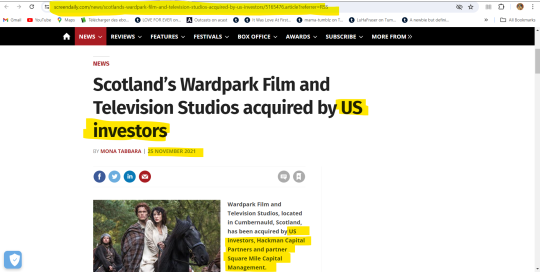

The story begins in 2013, with an ambitious Scottish entrepreneur, Terry Thomson - this guy (courtesy of The Herald, https://www.heraldscotland.com/news/15984820.analysis-three-projects-pipeline-help-productions-make-big-picture/):
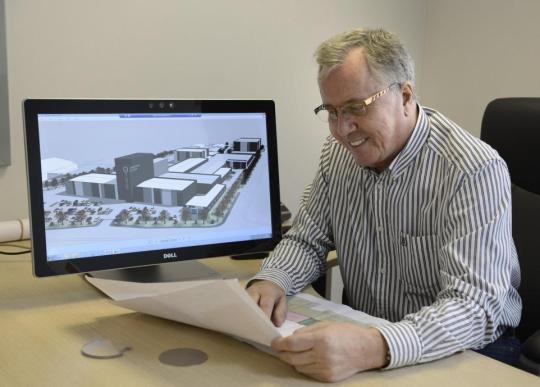
He is the owner of the Thomson Pettie Group, based in Carluke (https://www.thomsonpettie.com/about-us), which has nothing to do with cinema:

You've read that right: they are 'manufacturers of fabricated metal parts and assemblies', primarily for the national automotive industry. Yet, in 2013, Mr. Thomson agreed to rent what he described as 'a dormant industrial property' - a warehouse, to be exact - to Sony, in order to host the filming and production of OL. Thus, he became the CEO of a newly created entity, The Wardpark Film and Television Studios (https://www.hackmancapital.com/scotlands-largest-most-iconic-film-studio-acquired-by-hackman-capital-partners-and-square-mile-capital/).
By 2017, Wardpark was doing so well, that a big expansion plan was announced, with the direct support of the Scottish Government, which invested £4 million via Scottish Enterprise, its business support, advice and funding agency:

And then, in November 2021, the little engine that could was sold to those two big US investors, Hackman Capital Partners (HCP) and Square Mile Capital Management LLC (now globally rebranded as Affinius Capital). In this montage, Hackman Capital Partners brought its own confirmed film studios and media management expertise...
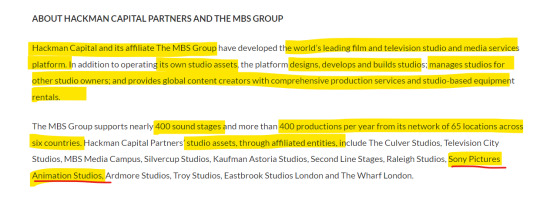
... while Square Mile most probably funded a sizeable portion of the acquisition, simply because this is what they do best:

Perhaps an interesting detail: HCP owns and manages both the Culver City based Sony Pictures Animation Studios' Campus and the legendary Culver Studios, now rebranded by Amazon:

Back to Scotland, Wardpark Studio's sale made just about everyone happy. Mr. Thomson kept his CEO job and look who was more than thrilled about the juicy transaction:
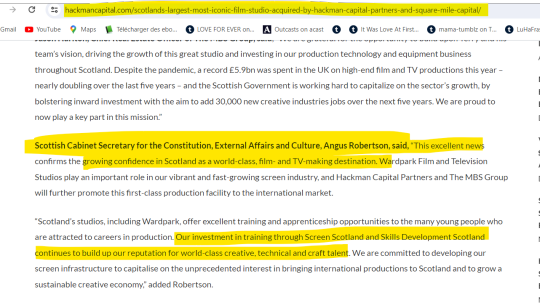
Currently, the studio is operated by HCP's subsidiary, The MBS Group:

That means that MBS probably manages just about everything, as far as daily management is concerned, from business operations, staffing and/or property management, to lighting and grip, trucks and generators' fleet, expendables and props. Unless I could see a contract and have a precise idea, I can just enumerate all the services they offer.
At no point in time did S and C own anything of those studios. As for the Executive Producer part, that is another discussion entirely. I could be coaxed to write something about it, if you really want to know why Those Two are EPs and what does that really, really mean - because once again, I have seen and read a LOT of bullshit in here, especially in the Desperate Housewives Disgruntled Tumblrettes' corner.
Thank you for asking. It was fun to research and write and I hope it brought more clarity to you.
99 notes
·
View notes
Text
The aviation industry is “failing dramatically” in its efforts to tackle its role in the climate crisis, according to a newly formed group of aviation professionals.
They say they are torn between their passion for flying and their concern for the planet and are calling for a fundamental transition of the industry, including controlling flight numbers.
The group, Call Aviation to Action, says the industry is overly optimistic about emissions-cutting technology and trapped in a business model that demands ever-growing flight numbers. The lack of significant climate action from the industry risks it being destroyed, the group says, as heavy regulation from outside will become necessary as the climate crisis intensifies.
Due to their international nature, carbon dioxide emissions from aviation are excluded from the national plans that countries submit to the UN’s climate body. Instead, the UN’s aviation body, the International Civil Aviation Organization (ICAO), is tasked with tackling the planet-heating gases.
Bockstael said: “My view is ICAO have been failing dramatically on that responsibility, because the only thing it came up with after eight years of discussion is the Corsia scheme, which is nothing more than carbon offsets for the growth of aviation above a certain threshold, exporting your problem to another industry.” The scheme has been criticised as “unambitious and problematic” and has yet to require any airline to use a carbon credit.
He said: “If we do not act, by 2050 aviation emissions will be about a quarter of all human-caused emissions – that will be really a very shameful position.
The Guardian has previously been contacted by numerous aviation professionals concerned about the climate crisis but who felt unable to speak publicly.
Flying causes more CO2 emissions than any other form of transport per mile and is dominated by rich passengers, with 1% of the world’s population responsible for 50% of aviation emissions. The industry’s climate plans are rated “critically insufficient” by Climate Action Tracker.
ICAO forecasts a doubling of passenger numbers by 2042, and the industry argues that more efficient aircraft, sustainable fuels and Corsia can control CO2 emissions. The ICAO has been accused of having been captured by the industry, the Guardian reported in February.
Independent experts say the feasible scale of measures to cut aviation emissions is extremely unlikely to compensate for such a doubling in traffic, with, for example, fuel-efficiency improvements now stalling. The CEO of Qatar Airways called the airline industry’s emissions goals a “PR exercise” in 2023.
The Call Aviation to Action group said the industry should set targets for absolute emissions cuts in line with science-based CO2 budgets and stop “lobbying against climate policies”. The industry should also acknowledge that managing global demand for flights in a fair way is part of the solution, it said.
Bockstael said the cost of emissions-cutting technologies would increase the price of flying but that additional measures, such as flight or carbon taxes, could be needed to keep passenger numbers at sustainable levels. Such constraints on demand must be fair, he said, offering equitable access to flying in developing countries and addressing heavy frequent flyers in rich nations.
Finlay Asher, an aerospace engineer and member of Safe Landing, said: “As an engineer, what really excites me is that the Call Aviation to Action proposals would lead to a new golden age of innovation. Our industry is in need of an upgrade: new aircraft designs, new forms of zero-carbon power and new airport layouts to support these. The research, development and operation of this new air transport system will not only create more jobs but also make flying greener, cleaner, quieter and more accessible to society.”
15 notes
·
View notes
Text
The term “Modern AU” for Naruto fandom needs to die. (Jk, sort of). It needs a new name, for ontologies sake.
Like. There is no consistency to the technological advancement in Naruto at all, but nonetheless, it is a demonstrable product of its initial years of development, which is the 90’s.
Throughout pt1 and Shippuden, we get a weird and nonsensical mix of Showa era (all of it, from 1886-1949) postwar period (1947-1980 thereabouts, though Wikipedia will disagree with me on that) and mid-late 90’s tech boom.
Now you could solidly argue for a “modern” interpretation of the Showa-era systems and customs, although that very much interferes with 1. the Uchiha as a clan, because they are 100% late Showa / WW2 period culturally. Hyuuga are more representative of the earlier Showa era, like 1920’s or so. SO yes you could do away with that, but frankly those clans are not themselves outside of that satirical context. (And I do actually think Kishimoto meant it to be satire, or at least his editor, who came up with most of the Uchiha premise, did). And
2. The whole Shinobi premise, which had still-living threads during that time period despite Shinobi as a profession supposedly dying in the 1850’s. (Pfffffft, Like mercenaries went anywhere during the European renaissance; they simply went from mercs to commissioned officers. Title change but not role change. Same idea.)
Furthering this, if you take them out of the dirt, so to speak, then they cease to have the in-universe function that they do. They don’t have to — you can still absolutely mock up a Mercenary-Paramilitary-Mage Caste for the “modern” world, by which is typically meant: In Japan/Our World, not the NarutoVerse.
Yes I know I’m being pedantic, but to say “modern” implies “past” and while there’s lots of that in Naruto, there’s also:
90’s Telephones (why doesn’t the Hokage have one in their office??? Landline is pretty darn secure.)
90’s Electricity
Computers (90’s era, but clunky things with limited functionality but can store data)
Floppy Disks to go with the above
Security cameras
Polaroids (again, 90’s era)
The cutting-edge-of-its-time (90’s again) radio collars
Industrial production of steel (how? We don’t know. But they can build 80’s-90’s skyscrapers, somehow.)
Steam engine (not that impressive or modern, but like, Where Are The Trains. We got 90’s steam boats in Kiri, but no locomotives? How? Why?)
Medical devices. Oh the list I could make about that. All like mid- late 90’s, at least in Konoha/Orochimaru and Co. The iron lung does not exist, replaced by stately 1999-2002 ventilators. (Kimmimaro) The concept of IV nutrition exists and is applicable, even if Kishi did an absolutely abysmal job of demonstrating that. (On Kakashi) (the reality: So. Many. Ports.) That little innovation didn’t exist until 1982, and didn’t actually work until 1996. (Because figuring out how to synthesize metabolic fats and proteins was really hard); you’ve got Ostomy tubes and bags that belong in 1995, (Kimmimaro again) and don’t even get me started on Lab equipment. Do you know how long it took to produce incubators that didn’t take up a quarter of a room? Do you have any idea what the world of cloning looked like in the 90’s? (Actually, it was a lot more advanced at that point than it is in Naruto, which is stuck in like, 1980’s with that notion).
And I could go on!
And there is just as many examples of the inverse, too, where there’s things juxtaposed to the past level. Example:
Psychiatric care. Granted we don’t see a lot of that outside of Kakashi’s little stint, but it is very 1940’s-1950’s type BS.
Similar to that, most the stuff in the Interrogation Unit. From attitudes to technology, but mostly in just the very weird, 1930-1950’s way the whole thing operates. Kishimoto did not do his research there, very obviously (Torture does not work like that), but nonetheless they give me Nazi vibes. (Well, Inaba and Ibiki do, respectively). That part might be intentional, but it still doesn’t really make sense in the bigger scope. (Why doesn’t the village know things when they are a SHINOBI VILLAGE. A postwar village no less! Make it make sense Kishi!)
Some elements of medicine. There’s a very weird divide there, between synthesized chemicals that are complex poisons, which SHOULD mean complex medicines exist, (because the only difference between medicine and poison is the dose and many toxins have medical value) and the demonstration of this, which relies upon herbalism. I suppose both those would exist in a Shinobi’s world, but there’s a bizarre element of “only the bad guys actually have good medicine” going on, which again is a very 1940-1950’s thing.
Idk, I feel like “modern” sort of fits? But not entirely. Because fundamentally the NarutoVerse is a completely separate dimension, a twisted alternate reality that is very removed from our own yet also very like it.
Gahhhhh the world building in this series is hot, messy garbage 🤣
I would love to see an AU where it’s more homogeneous, like smack-dab postwar all over the board. Or even just bring her up to the 90’s. That would be actual modern-NarutoVerse.
But using Modern to mean “Our World” has always just been a small thing to bugger me. Use what you want, because I don’t think the term is going anywhere, but if I can’t share this anywhere else I can share it here.
29 notes
·
View notes
Text
According to research by the Campaign Against the Arms Trade (CAAT), the UK has licensed more than £472 million in arms exports to Israel since 2015. This includes tank components, armour-piercing ammunition and small arms, but, in keeping with the structure of the British weapons industry, aerospace components for fighters and drones predominate. It’s difficult to get clear numbers from the arms industry. The headline figure is taken from the value of standard licences, but the UK also operates a system of open licences that permit transfers of unlimited – and unspecified – quantities of particular military goods. Since 2015, 57 such licences have been granted for export to Israel, ten of those in 2022. They include British components for the American-designed F-35 aircraft, which campaigners estimate have been worth £336 million to the companies (primarily BAE Systems) producing them. Because the quantities of goods issued under open licences are not made public, groups such as CAAT have to back-engineer their value. In recent years the government has become increasingly hostile to Freedom of Information requests on arms, but there is enough publicly available data to be certain that the planes currently flattening apartment blocks and refugee camps in Gaza rely on components engineered and manufactured in Britain. There is little appetite in Westminster for reform of the domestic arms industry. For one thing, it is a rare economic success story. The UK is the second largest exporter of defence items in the world and, according to the Stockholm International Peace Research Initiative, the sixth largest exporter of major conventional weapons (which means everything short of weapons of mass destruction), primarily aircraft. The total value of standard licences issued in 2021 was £10.7 billion, and the industry depends on its aerospace sector, which accounts for 72 per cent of export business. More than half of all British defence exports go to the Middle East – but to Saudi Arabia rather than Israel. Human rights organisations, including Amnesty International, accuse BAE Systems of being party to Saudi war crimes in Yemen, where BAE-supplied (and serviced) fighters have bombed schools and hospitals.
James Butler, Up in Arms
122 notes
·
View notes
Text
3D Printing in Architecture

3D printing, once a novelty in the tech world, has now firmly established itself as a game-changer in various industries, including architecture. The ability to create intricate models, prototypes, and even full-scale structures has opened up new possibilities for architects, engineers, and builders. In this blog post, we'll explore how 3D printing is revolutionizing architecture, from design concepts to construction practices.
Design Innovation
One of the most significant impacts of 3D printing in architecture is the freedom it provides in design. Traditional methods often limit architects to certain shapes and structures due to material and construction constraints. However, with 3D printing, these limitations are lifted. Architects can now experiment with complex geometries and organic forms that were previously impossible or too costly to achieve. This has led to a surge in innovative designs, pushing the boundaries of what architecture can be.
Prototyping and Modeling
Before the advent of 3D printing, creating detailed architectural models was a time-consuming and expensive process. With 3D printing, architects can quickly produce accurate scale models of their designs, allowing for better visualization and refinement. This rapid prototyping capability enables architects to identify potential issues early in the design process, saving time and resources in the long run. Additionally, clients can better understand the architect's vision through tangible models, leading to more effective communication and collaboration.
Sustainability and Efficiency
3D printing also offers significant benefits in terms of sustainability and construction efficiency. Traditional construction methods often generate a considerable amount of waste due to material overuse and mistakes. In contrast, 3D printing uses only the necessary amount of material, significantly reducing waste. Additionally, many 3D printing materials can be recycled or are made from sustainable resources, making this technology more environmentally friendly.
Moreover, 3D printing can streamline the construction process. Structures can be printed on-site, reducing the need for transportation and minimizing the carbon footprint associated with moving materials and equipment. This method also allows for faster construction times, which is particularly beneficial for large-scale projects or emergency housing needs.
Cost-Effective Construction
The cost of building with traditional methods can be prohibitive, especially for complex or custom designs. 3D printing offers a more cost-effective alternative by reducing labor costs and material waste. The precision of 3D printing ensures that only the exact amount of material needed is used, which not only lowers costs but also increases the structural integrity of the building. For developing countries or regions with limited resources, 3D printing presents a viable solution for affordable housing and infrastructure.
Challenges and Future Prospects
While 3D printing in architecture holds great promise, it is not without challenges. The technology is still relatively new, and large-scale 3D printing for buildings requires further development. Issues such as material limitations, regulatory hurdles, and the need for skilled operators must be addressed. However, ongoing research and innovation in the field are likely to overcome these challenges in the coming years.
#architectdesign#design#interior design#home interior#interiordoor#interior decorating#architecture#interiorstyling#interiors#home#3D#3d printing
34 notes
·
View notes
Text

An Introduction to Cybersecurity
I created this post for the Studyblr Masterpost Jam, check out the tag for more cool masterposts from folks in the studyblr community!
What is cybersecurity?
Cybersecurity is all about securing technology and processes - making sure that the software, hardware, and networks that run the world do exactly what they need to do and can't be abused by bad actors.
The CIA triad is a concept used to explain the three goals of cybersecurity. The pieces are:
Confidentiality: ensuring that information is kept secret, so it can only be viewed by the people who are allowed to do so. This involves encrypting data, requiring authentication before viewing data, and more.
Integrity: ensuring that information is trustworthy and cannot be tampered with. For example, this involves making sure that no one changes the contents of the file you're trying to download or intercepts your text messages.
Availability: ensuring that the services you need are there when you need them. Blocking every single person from accessing a piece of valuable information would be secure, but completely unusable, so we have to think about availability. This can also mean blocking DDoS attacks or fixing flaws in software that cause crashes or service issues.
What are some specializations within cybersecurity? What do cybersecurity professionals do?
incident response
digital forensics (often combined with incident response in the acronym DFIR)
reverse engineering
cryptography
governance/compliance/risk management
penetration testing/ethical hacking
vulnerability research/bug bounty
threat intelligence
cloud security
industrial/IoT security, often called Operational Technology (OT)
security engineering/writing code for cybersecurity tools (this is what I do!)
and more!
Where do cybersecurity professionals work?
I view the industry in three big chunks: vendors, everyday companies (for lack of a better term), and government. It's more complicated than that, but it helps.
Vendors make and sell security tools or services to other companies. Some examples are Crowdstrike, Cisco, Microsoft, Palo Alto, EY, etc. Vendors can be giant multinational corporations or small startups. Security tools can include software and hardware, while services can include consulting, technical support, or incident response or digital forensics services. Some companies are Managed Security Service Providers (MSSPs), which means that they serve as the security team for many other (often small) businesses.
Everyday companies include everyone from giant companies like Coca-Cola to the mom and pop shop down the street. Every company is a tech company now, and someone has to be in charge of securing things. Some businesses will have their own internal security teams that respond to incidents. Many companies buy tools provided by vendors like the ones above, and someone has to manage them. Small companies with small tech departments might dump all cybersecurity responsibilities on the IT team (or outsource things to a MSSP), or larger ones may have a dedicated security staff.
Government cybersecurity work can involve a lot of things, from securing the local water supply to working for the big three letter agencies. In the U.S. at least, there are also a lot of government contractors, who are their own individual companies but the vast majority of what they do is for the government. MITRE is one example, and the federal research labs and some university-affiliated labs are an extension of this. Government work and military contractor work are where geopolitics and ethics come into play most clearly, so just… be mindful.
What do academics in cybersecurity research?
A wide variety of things! You can get a good idea by browsing the papers from the ACM's Computer and Communications Security Conference. Some of the big research areas that I'm aware of are:
cryptography & post-quantum cryptography
machine learning model security & alignment
formal proofs of a program & programming language security
security & privacy
security of network protocols
vulnerability research & developing new attack vectors
Cybersecurity seems niche at first, but it actually covers a huge range of topics all across technology and policy. It's vital to running the world today, and I'm obviously biased but I think it's a fascinating topic to learn about. I'll be posting a new cybersecurity masterpost each day this week as a part of the #StudyblrMasterpostJam, so keep an eye out for tomorrow's post! In the meantime, check out the tag and see what other folks are posting about :D
#studyblrmasterpostjam#studyblr#cybersecurity#masterpost#ref#I love that this challenge is just a reason for people to talk about their passions and I'm so excited to read what everyone posts!
47 notes
·
View notes
Text
Major Players in the War Against the Firmament

The Republic of Stauros
The Republic of Stauros is a global superpower that controls the Americas and much of eastern and southern Africa, its imperialist agenda funded by the exploitation of abundant natural resources. This influx of resources means that they have been able to rapidly advance technology, particularly in bio-science, engineering, and materials science fields, and their advanced technology in turn makes for political capital with which they can bully nations into being subsumed by the Republic.
Stauros is a meritocratic oligarchy with republican structures, and presents itself as being a place where the best can rise to the top. It is centrally governed in its capital of Etorios, by a council of (what were originally) six departments that oversee facets of government such as treasury, military, agriculture, etc. These department heads are chosen from among a democratically elected parliament that makes up the upper levels of each department by the previous council. In short, the system rejects change very stubbornly as those who are eligible to lead have been entrenched in the system for a very long time. This entrenchment means that the Republic, while founded on progressive ideals, has now fully embraced the authoritarian streak that has haunted it since its inception.
Most prominent in Stauros's war against the Firmament is the ExoCorps, the executive arm of the Department of the Exterior. The Dept of the Exterior was created in order to protect Stauros's offplanet interests, however in the decades since they have come to rival the power of the Dept of Military, even surpassing it in many instances. The most notable example of this power imbalance is in the ExoCorps' development of Synaptic Transfer technology and the resulting Janissary program.

The Sophic Church
The Sophic Church originated as part of the Third Awakening, a reactionary revival in religiosity coupled with anti-Christian sentiment and strong undercurrents of paranoia brought about by a sharp rise in conspiratorial thought. What were several grassroots Gnostic revival movements came together to form a single ecclesiastical society, united in their desire to dismantle current institutions and build something new. These movements, originally different sects, syncretized their beliefs, though after several decades of transformation, their doctrine has evolved into a largely ahistorical conflation of Valentinianism and Sethianism alongside some entirely new ideas.
The Sophic Church played a key role in the formation of the Republic and rose alongside it, shaping it in the process, and as a result, within Stauros there is a strong presumption that most residents of the Republic are a part of the church.
Naturally, due to this relationship the Church has amassed a large amount of wealth and influence, and has invested this wealth into a number of corporate assets. The most prominent among these is Ascension, a corporation with child companies for mining, manufacturing, logistics, pharmaceuticals, and many other industries.
As a result, the Sophic Church has control over a substantial amount of the economy not just of Stauros, but the rest of the world as well.

The Stereomatos
In 2068, Olympia, Stauros's first permanent Martian research base, collapsed due to mismanagement. Due to the nature of the Stauros Dept of Research's control over the research base, while researchers lived permanent lives on base and even raised families there, leadership was not only appointed from a bureaucracy located on Earth, but also frequently rotated. As a result, most Directors of Operations viewed the position only as a temporary station, and ultimately failed to carry out their duties.
This culminated in 2067, when a failure in the water system caused dozens of people to become ill and 14 deaths. Civil unrest had already started to stir, but now was in full swing.
A nearby ExoCorps detachment was then stationed inside the colony to dissuade uprising, but the additional strain on resources that they caused served only to exacerbate discontentment. Before any violence broke out, the base was declared no longer fit for human habitation and disbanded, its residents either returned to earth or stationed in other colonies. The base was leveled shortly thereafter.
A mere two years later, Synesia was founded on Olympia's ruins. Synesia was intended to serve as a colony and an experiment in autonomous government, as well as a center for Stauros' civic operations offplanet. This quickly expanded into a semi-autonomous satellite state, granted nominal independence by Stauros in return for serving as the governing body for bases and offplanet stations too large and too distant from Earth in order to be effectively managed by a planetary bureaucracy.
In practice, the Stereomatos is a puppet state. Most of its leadership is either beholden or sympathetic to Stauros, and lives under constant threat of dismantlement. Stauros maintains exclusive trading rights with the Stereomatos, and uses the leverage of their monopoly on space infrastructure as means of controlling the nation.

The Firmament
The Firmament is a revolutionary movement across the Stereomatos with the ultimate goal of eliminating Stauros control over space.
The movement is comprised of several cells across both inner sphere and outer sphere colonies and stations, which frequently work together to improve the living conditions of Stereomatos citizens, smuggle goods and resources across planetary boundaries, and wage asymmetric warfare against Stauros.
The Firmament's immediate strategy is to hold Stauros at resource-point through piracy and targeted attacks on military installations so that they'll agree to several key conditions:
The right to self-govern independent of Stauros control, including reforming the government from a parliamentary republic into a syndical state.
Better access to tertiary industry, including the means to utilize synaptic transfer tech
Access to Stauros trade networks in order to carry out trade with other nations with minimal interference
The Stereomatos as a whole may be generally divided in their opinion on the Firmament's methods, however it is an unspoken rule to side with them whenever possible, because the Firmament represents hope for a freer future and an end to overcrowding and military police actions. Even those ideologically opposed tend to avoid speaking out, because the members of the Firmament are ultimately members of their community. A number of Stereomatos politicians have direct connections to Firmament leadership, and work to achieve the movement's aims through diplomatic means.
On Earth, however, the opinion is generally much more divided. Typically the details of their actions are largely reduced to the effect that they've had on Stauros, and are branded terrorists due to civilian casualties from their attacks. Within Stauros, media is sufficiently skewed that those who are aware of them despise them. Outside of Stauros, the Stereomatos is shown more sympathy, and even those who skew more conservative are open to the idea of free trade with the Stereomatos.

Federated Oceania
As climate change ravaged the global south, Aotearoa (formerly New Zealand) successfully pushed back the encroaching ocean with a sea wall, reclaiming additional land in the process. Having secured their new position as a safe haven for climate refugees, they pushed Australia into adopting a similar strategy. As a means of allowing displaced people to retain their sovereignty as well as protect against the threat of a subjugation-hungry Stauros on the horizon, the bloc of Federated Oceania was formed.
With a vested interest in environmental sciences and sustainable energy, Oceania rose to prominence by implementing the first viable fusion reactor and selling off excess energy from successive plants. This paved the way to further successes until it became the non-Stauros leader in technology on a global stage, and served as the first country to challenge Stauros's self-proclaimed "monopoly on space".
As a staunch rival of Stauros, Oceania is one of the few terrestrial nations to openly provide support the Firmament.

The Archon Program
The disappearance of the Caesarea is a mainstay of conspiracy circles system-wide. From independent blogs hosted on the clearnet to chatrooms on planetside LITEs to forums and message boards maintained on Firmnet servers in the belt, no hushed whisper passes through the internet's lips without mentioning its name, and the Caesarea is rarely mentioned without the words "Archon program" in its wake.
However, there is little consensus on what those words mean.
They say that Archon Program is run by the Dept of the Exterior— no, by the Sophic Church— no, it's the secret Dept of Suppression— as a psyop— actually, it's in order to crush unions (the IPU has NEVER been able to touch Ascension)— no, to serve as a counter to the Firmament's dark matter bomb— and eventually, to dominate the world— utilizing heinous machines that are larger than any Cataphract, that bleed, that drive their enemies and pilots to madness.
When asked for proof, however, the stories converge. A would-be whistleblower from Ascension Aerospace, killed when lightning struck her complex as she was uploading the leak, severing the connection and her life at once. All that was uploaded was the first gigabyte of a single file, titled Archon Program, completely blank except for the image of an A with an ouroboros divided into seven pieces.
Nothing more is known by the public.
85 notes
·
View notes
Text
10 Cool Jewish Women from Modern Day! Part 2 because I'm on a role
Liz Kleinrock, a self-described "Korean, Jewish, queer, transracial adoptee, antibias and antiracist nationally recognized educator, author, and consultant." Born in Korea, she was adopted by an Ashkenazi Jewish family in Washington D.C.. Involved in education, with a Masters in UCLA's Teacher Education Program, she has taught in California and D.C., and has also worked as a school librarian. In 2018, she received Learning for Justice's Award for Excellence in Teaching.
Loolwa Khazzoom, an Iraqi-American writer, journalist, activist, musician, and feminist. She was heavily involved in the Jewish feminist movement of the 1990s and is the founder of the Jewish Multicultural Project, which provides resources to Jewish communities about diversity in Jewish culture. She has also been involved in SOJIAC and JIMENA. Raised in California to an American Jewish mother and an Iraqi Jewish father, she graduated from Barnard College in 1991. She participated in a filming about the interplay of race and gender in America called The Way Home. She is the lead singer and bass player of Iraqis in Pajamas, a punk rock band that uses traditional Iraqi and Jewish musical elements.
Ariela Sofer, and Israeli and American operations researcher who is a professor of systems engineering and operations research, as well as a Divisional Dean, at George Mason Acamdey. She is a published author, with two books on Lineaer and Nonlinear Programming. Named as a Fellow of the Institute for Operations Research and the Management Sciences in 2016, she is also a Fellow of the Institute of Industrial and System Engineers and the International Council on Systems Engineering.
Ayelet Newman, also known as Ayelet the Kosher Comic, is an Orthodox stand up comedian. Born to a secular Jewish family on long Island, she pursued a career in TV and film after high school, appearing in The Hebrew Hammer. She became a baalat teshuva in the early 2000s, when she quit acting and began pursuing comedy, performing only for women.
Adina Sash, a Brooklyn raised American Jewish activist and social media influencer, also known as FlatbushGirl. Holding a Master's degree in Medieval literature from Brooklyn College, her online activism was started after receiving sexist comments. In 2017,s he launched a social media campaign called #FrumWomenHaveFaces that raised awareness of the erasing of women from Orthodox newspapers and magazine, gaining the support of Mayim Bialik (Jewish actress).
Tova Ben-Dov, former president of the Women's International Zionist Organization and former vice president of the World Jewish Congress, as well as a board member for the Jewish Agency for Israel and the International Alliance of Women. She joined WIZO as a young mother, and worked in the Chair of Women's Training Department of WIZO Israel. In 2011, she was awarded Honoree of Tel Aviv, and in 2016 the title of Honorary Fellow of the World Zionist Congress.
Kat Graham, an American actress, singer, dancer, author, and activist. Born in Geneva, Switzerland, to an Americo-Liberian father and a Polish and Russian Jewish mother. Co-founder of he wellness company Modern Nirvana, she had released work focusing on self-help. She speaks English, French, Spanish, and some Hebrew and Portuguese. She is known for her role as Bonnie Bennett on the CW show The Vampire Diaries, and has released two extended plays and four studio albums. She has done work as a Goodwill Ambassador for the UN Refugee Agency, inspired by her family's history.
Dafna Bar-Sagi, an Israeli born cell biologist and cancer researcher at New York University School of Medicine. She is member of the scientific advisory boards, including the National Cancer Institute. A graduate of Bar-Ilan, where she earned her undergraduate and master's in neurobiology, she received her PhD in neurobiology from the State University of New York as Stony Brook. Her research focuses on the nature of he Ras oncogene and how Ras signaling leads to tumor development. She has been the vice dean for science, chief scientific officer, and executive vice president of NYU Langone Health.
Malika Kalontarova, a Tajikistan born Bukharian dancer known as the "Queen of Tajik and Oriental Dance." Rebellious as a child, she has always identified as Jewish, despite Antisemitism in Tajikstan. Trained by Ghaffor Valamatzoda and Remziye Tarsinova, she moved to Queens in 1993 where she opened up her own dance studio.
Jazz Jennings, an American spokeswoman and Queer activist. An honorary co-founder of he TransKids Purple Rainbow Foundation, which her parents founded in 2007, she is one of the youngest documented people to be recorded as transgender. She was accepted into and currently attends Harvard University. In 2013, at only 13 years old, she founded Purple Rainbow Tails, while engaging in a battle with the USSF to allow her to play on a girls' soccer team. She is a published author, and in 2014 was named one of the top 25 most influential teens. She has voiced several characters in an animated shows, and starred in an Amazon Prime movie.
12 notes
·
View notes
Text
more stark tower info: employees/staff
aight y'all know the drill, long post read below take w a grain of salt use in your own stuff if you want just pls credit!!!
Stark Industries Corporate Offices
Standard offices for legal, HR, finance, PR, business development.
100–150 employees per floor.
Estimated Employees: ~3,000–3,500
Research & Development, AI, & Cybernetics
Labs for AI development, cybernetics, energy research, and defense tech.
50–80 scientists/engineers per floor.
Estimated Employees: ~600–900
Secure Weapons & Suit R&D, Advanced Tech Labs
Classified research with fewer but highly specialized staff.
40–60 engineers per floor.
Estimated Employees: ~400–600
Security Personnel
On rotation across lobby, underground, R&D areas, and executive floors.
1,000+ security staff total, but ~300-400 on-site at a time.
Estimated On-Site Security Staff: ~300-400
Industrial Storage, Robotics, Engineering Workshops
Large-scale robotics & AI facilities.
50–100 engineers per level.
Estimated Employees: ~800–1,200
Additional Support Staff Breakdown
Food Services (Restaurants, Café, Lounge)
In-house restaurant & café: Serves thousands daily.
Chefs, baristas, waitstaff, managers.
Estimated Employees: ~250-300
Housekeeping & Cleaning Crew
Cleaning for 73 floors + underground.
Day & night shift crews rotating.
Estimated Employees: ~400-500
Maintenance & IT Support
Building engineers, electricians, IT, and HVAC technicians.
Estimated Employees: ~300-400
Personal Assistants & Admin Staff
High-level executive assistants, receptionists, and schedulers.
Estimated Employees: ~150-200
Interns & Entry-Level Workers
STEM interns, business interns, and apprentices.
Estimated Employees: ~200-300
TOTAL: 6,400–7,800 Employees
Daily on-site occupancy likely 5,000–6,000 people at peak hours.
Events, high-security operations, or crises could temporarily raise staffing needs.
other info
contract tour guides also give regular tours of the publicly accessible parts of Stark Tower
tours are available to the public, and for schools/private organizations
tour guides are contract workers for a tourism company that work with Stark Tower and tons of other places in Manhattan
security levels
still working on security clearance levels lol but keep in mind that all departments have a hierarchy of clearance
like within housekeeping the more entry level positions work in the public parts of the tower, and the higher ranking/more trusted employees work in the more secure areas
this does extend all the way to Tony's penthouse and the Avengers areas
staff in these high security areas have to go through a lot of measures (NDAs, fingerprinting, getting their DNA on file etc) and are also monitored constantly
which might sound overkill until you think about how many times people have tried to kill Tony. also there are literal government secrets up in that bitch. so yeah. good pay good job security as long as you don't fuck around where you're not supposed to
realistically Tony probably will also have cleaning drones for some more dangerous or ultra secure areas. The people who do maintenance on those robots are also under heavy security protocols to make sure they don't sabotage anything
visuals for the rooms and floors coming soon!!
DISCLAIMER: the lists of employees and their numbers were partially generated with chatgpt, everything else (other info and security levels) was organically written by me without the use of ai
#op's world building (we're just living in it)#stark tower#tony stark#mcu#marvel cinematic universe#avengers#avengers headcanons#mcu headcanons#marvel headcanons#also PHAT shout out to chatgpt because I cannot do math#thank you for essentially being my robot therapist and ironing out all the wrinkly scrungkly little thoughts I push into your doggy door#chatgpt my beloved <3#tw ai
11 notes
·
View notes